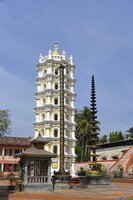| dc.coverage.spatial | Site: Mardol, Goa, India | en_US |
| dc.coverage.temporal | 17th century (creation) | en_US |
| dc.creator | unknown (Indian (South Asian)) | en_US |
| dc.date | 1600-1699 | en_US |
| dc.date.accessioned | 2016-06-21T19:09:53Z | |
| dc.date.available | 2016-06-21T19:09:53Z | |
| dc.date.issued | 1600-1699 | en_US |
| dc.identifier | 264552 | en_US |
| dc.identifier.other | archrefid: 3372 | en_US |
| dc.identifier.uri | http://hdl.handle.net/1721.3/180610 | |
| dc.description | Types of stambha or lat; left, dhvaja (flagpole stambha), center, deep stambha (lamp tower), right, samai (lamp); The temple complex is dedicated to the goddess Mahalasa who is identified with Mohini, the female avatar of the god Vishnu. One feature that marks Goan Hindu temple style is the modification of the lat or stambha pillar into a "lamp tower" (deep stambha) that can be lit with traditional oil lamps (diya). They are, as described by Jose Pereira: "a polygonal (octagonal) structure, with the corners of the polygons marked by engaged columns, the space between them being occupied by niches for lamps, and the whole crowned by an entablature surmounted by finials." These were influenced by Portuguese and Western architecture. The temple is also known for its exceptionally tall brass samai (an ornamental lamp pillar) which is 40 feet in height and has 21 rings of a hundred fifty small lamps. These are lit with oil wicks on festival days. Source: Wikipedia; http://en.wikipedia.org/wiki/Main_Page (accessed 8/25/2015) | en_US |
| dc.format.medium | wood; brass; copper; stucco; stone | en_US |
| dc.rights | © Scott Gilchrist, Archivision, Inc. | en_US |
| dc.subject | architecture | en_US |
| dc.subject | deities | en_US |
| dc.subject | Hinduism | en_US |
| dc.subject | Indo-Portuguese | en_US |
| dc.subject | Seventeenth century | en_US |
| dc.title | Mahalasa Narayani Temple | en_US |
| dc.title.alternative | Shri Mahalasa Devasthan | en_US |
| dc.type | image | en_US |
| dc.rights.access | Licensed for educational and research use by the MIT community only | en_US |
| dc.identifier.vendorcode | 1A2-IN-G-MNT-A10 | en_US |
| vra.culturalContext | Indian (South Asian) | en_US |
| vra.technique | construction (assembling), carving (processes), painting and painting techniques | en_US |
| vra.worktype | lat (pillar) | en_US |
| vra.worktype | temple | en_US |
| dc.contributor.display | unknown (Indian (South Asian)) | en_US |

